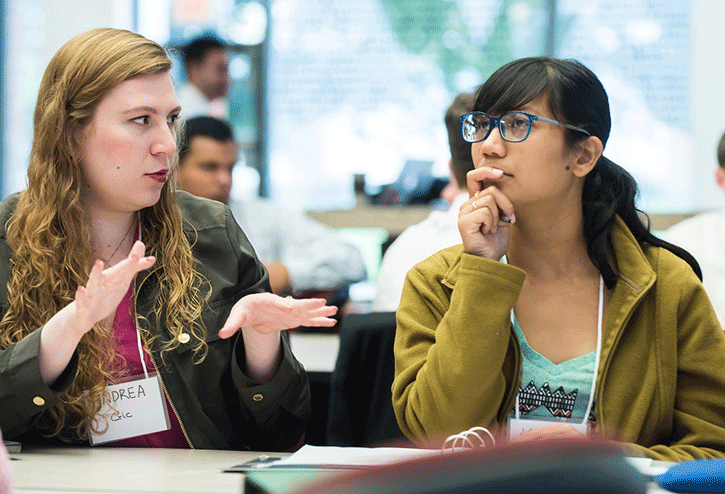
Kristine Mosuela, BS Civil Engineering ’17 (on right), meets with her teammate Andrea Nunez, BS Information Systems and Operations Management ’17, to discuss their project for the Mason Summer Entrepreneurship Accelerator program (MSEA).
Launching a new mobile app that motivates bike riders to track their progress sounds like a business idea that could take off quickly.
That’s what Kristine Mosuela, BS Civil Engineering ’17, and several other George Mason University students thought when they applied to participate in the Mason Summer Entrepreneurship Accelerator (MSEA), a new program that allows students and recent graduates to explore the commercialization potential for their product or service ideas.
Mosuela’s team was one of seven teams that worked together for two months this summer to hammer out the pros and cons of their business concepts. They conducted intense customer-related research and received input on their ideas from experienced entrepreneurial instructors and mentors.
Of the 26 participants in the MSEA program, 15 were engineering students or recent graduates. Each participant received a $4,000 stipend over the eight weeks. Mason Engineering contributed $30,000 to the summer program.
At the end, the teams had to decide whether their business idea was a “go” or “no go,” says Sean Mallon, Mason’s associate vice president for entrepreneurship and innovation. “We hoped that there was an opportunity to generate sustainable businesses out of their ideas, but that wasn’t a 100 percent expectation.”
Mosuela and her teammates didn’t fully create the app, but they had a nonfunctional prototype that showed how it would work.
Early on, their business model hit roadblocks. They interviewed bike riders and found most didn’t want to use an app to track their progress or connect with other riders. They also studied competitors who had tried but failed to market similar apps.
When they realized their idea wasn’t a viable startup business, they scrambled to come up with another one. By the end of the program, they had created a marketing plan for city and regional bus systems that featured paper maps and signage at bus stops that highlighted places of interest.
There was no app or digital element to their final product idea, a big disappointment to the app developers. “It took me a while to switch gears in my mind,” Mosuela says.
Other groups in the MSEA program also had to adapt their original concepts. Morgan Sisk, BS Bioengineering ’17, and her team, wanted to design a wearable device that measured heart rate and breathing feedback as a way to train military personnel, law enforcement officers, and recreational shooters to fire more accurately. “We thought we had a great idea that was going to be foolproof, and everybody would want it,” she says.
Team members traveled to the Federal Law Enforcement Training Centers in Glynco, Georgia, to interview federal gun instructors and researchers.
They discovered that their potential customers, mostly law enforcement agencies, didn’t want a device that provided biometric data but preferred a product that measured the initial motion of taking the gun out of the holster. The team is working on prototypes of a wristband device that does just that.
Sometimes the business reality is hard to accept. Taban Yazdani, BS Systems Engineering ’17, created a preliminary device that provides biofeedback to athletes to prevent knee injuries, but she discovered during the program that the market for her device was too limited.
“I spent every single day of last year on this project, and the day I realized that there was not enough of a market for it, I was really devastated,” she says.
Her original product idea is a “no go,” however she wants to continue with her project because she found a potential customer interested in other applications of her preliminary device.
Only a few of the seven teams may actually venture into a business, but everyone gained from the experience, says Mallon, who has more than 20 years of investment and startup experience. “I know for sure that the 26 students who participated in the MSEA program are never going to solve problems in the same way whether they work for the State Department, a high-growth technology company, or their own startup. They are going to approach a challenge and ask, ‘What does the customer want?’”
Others agree. The learning experience was invaluable, Mosuela says. “It was one of the most collaborative, critical thinking experiences I have ever had.”
The teams lead by recent engineering school graduates include:
Mosuela’s team. Andrea Nunez, BS Information Systems and Operations Management, ‘17; Tri Nguyen, Computer Science major; Jenn Ponce, Art and Visual Technology major
Sisk’s team. David Garcia, BS Bioengineering ’17; Carla Ortega, BS Electrical Engineering ’17; Forrest Bussler BS Bioengineering ’17
Yazdani’s team. William Mills, Economics major
I know for sure that the 26 students who participated in the MSEA program are never going to solve problems in the same way whether they work for the State Department, a high-growth technology company, or their own startup. They are going to approach a challenge and ask, ‘What does the customer want?’
Sean Mallon, associate vice president for entrepreneurship and innovation
